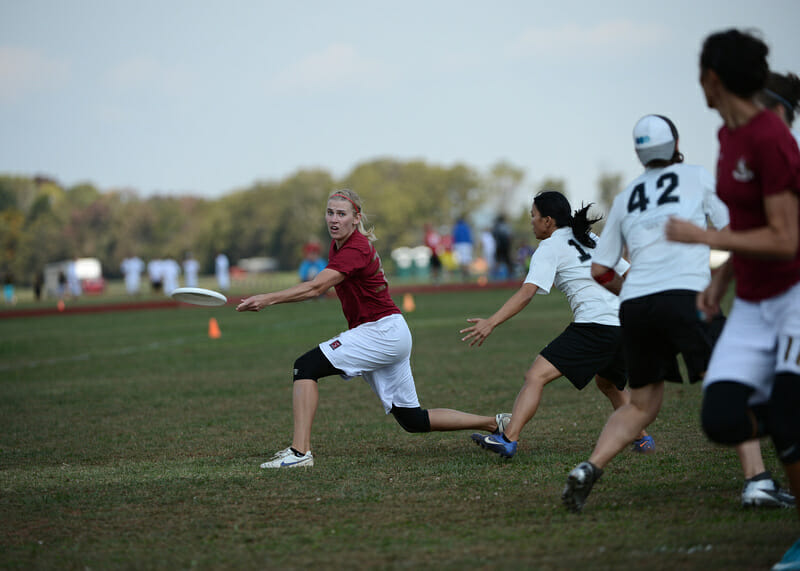Learning to Play Ultimate Frisbee
Posts here will emphasize tactics, but since the game starts with physical skills, here's a brief introduction to the physical skills of defense.
Physical Skills: Defense
Ultimate Frisbee is a non-contact sport in the same vein as basketball. You can't tackle an opponent, or grab arms or push them out of the way, but as a defender, you'll move closely with the person you're guarding.
Much of defense depends on choices, so it will be covered more under Tactics: Defense, but there are two physical skills that apply to most strategies.
Marking and Forcing
When you guard the thrower, you are the 'marker' and play a special role. You can't prevent all throws, but you can deny the easiest ones. Keep your hands wide and watch the disc (though as you get more experienced, you may want to glance upfield to spot incoming cuts).Foot blocks are allowed in some leagues, not in others. Hands are your best blocks: usually, you want to keep them low, as for most players, it's easier to throw under a blocker than over.
Most teams rely on the marker to 'force' the disc, preventing throws to one side. While it's possible to 'break' the force, with specialized throws like scoobers or simply with a good pivot, a good force makes throws to that side harder.
To force, stand with your body a step to the side where you are preventing throws. Reach out with both hands. Stay active, and step a bit to adjust to your thrower, but don't be drawn away from the side you are denying.
Many teams choose a side for forcing for an entire point or even a whole game, always forcing 'home' (toward the team) or 'away.' It's a practice I find too widely used (more thoughts on that under Tactics), but if yours does it, you do have an easy way to remember where the force is going.
If you are the marker, stand away from that side (to force 'home,' stand on the side away from your team). If you are another defender, stand closer to that side (if your marker is forcing 'home,' stand closer to your team than the person you are guarding, since he or she needs to run toward your team to get a disc from an unbroken force).
If choosing the force is up to you, call out loudly which way you are forcing (or 'straight up' for no force). Often, it's best to force back in the direction the disc came, at least for a moment. More about that under Tactics.
If a force is broken, call it out ('Broken!'), so your teammates know to shift their positions relative to your opponents.
Sometimes teams will always force a particular way against a known player with a particularly good forehand or backhand. Whether this is in the 'Spirit of the Game' depends on how it's applied, but in any case, be aware that you may be asked to mark a certain way with certain players.
A special case of forcing is the 'trap' against the sideline. It works the same way as any other force, but the thrower now has a much narrower open area. It's particularly effective when forcing the throw into the wind.
| The marker has trapped the disc, and the throw goes to the only open area, down the sideline. |
Some teams always trap when the disc is near the sideline.
I believe you can do better, especially near the endzone, but
that's covered more under Tactics. Other teams always force
'middle' (away from the side) when the thrower is near the endzone, and
still others trap as they apply a variation of zone defense to intercept throws down the line.
Guarding
Where's your target going? Wherever his or her hips turn.She can head-fake as much as she wants, or he can stop and start a dozen times, but if you want to know which direction is next, follow the hips.
If you are playing one-to-one matched defense, you'll stay with your person for the point (unless calling a 'Switch,' covered under Tactics). Then a 'Stack' is the most common offensive arrangement, placing all the teammates of the thrower in a column down the field.
On defense, you want to stay the side allowed open by any 'force' from your marker. If your marker forces 'home,' you stand closer to your team, since that's the way your defender must run to get an open throw. An effective 'home' force denies throws to the side away from your team. For an 'away' force, do the reverse.
Most players find it easier to face the person they're guarding, though some prefer to face the thrower. In any case, stand near your target, and note your position in the Stack. If you are far downfield, you are guarding someone with more chance of catching a long throw, so you need to shift accordingly. Play enough Ultimate and you'll hear the refrain, 'Don't get beat long.'
You want to stop any catch by your target, of course, but if you must let one through, make it happen close to the thrower. Don't get beat long.
















